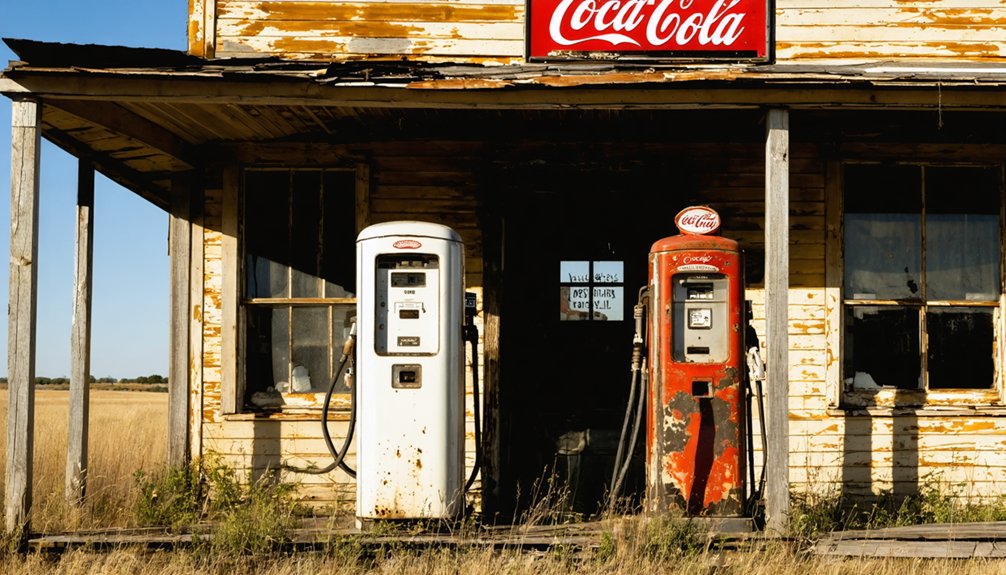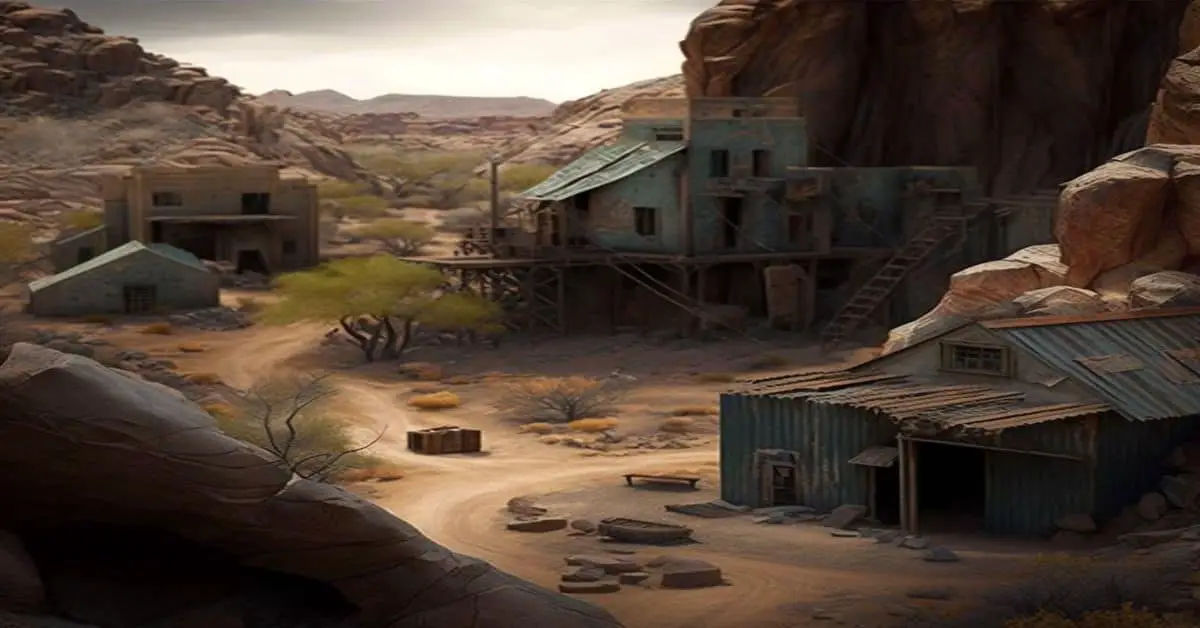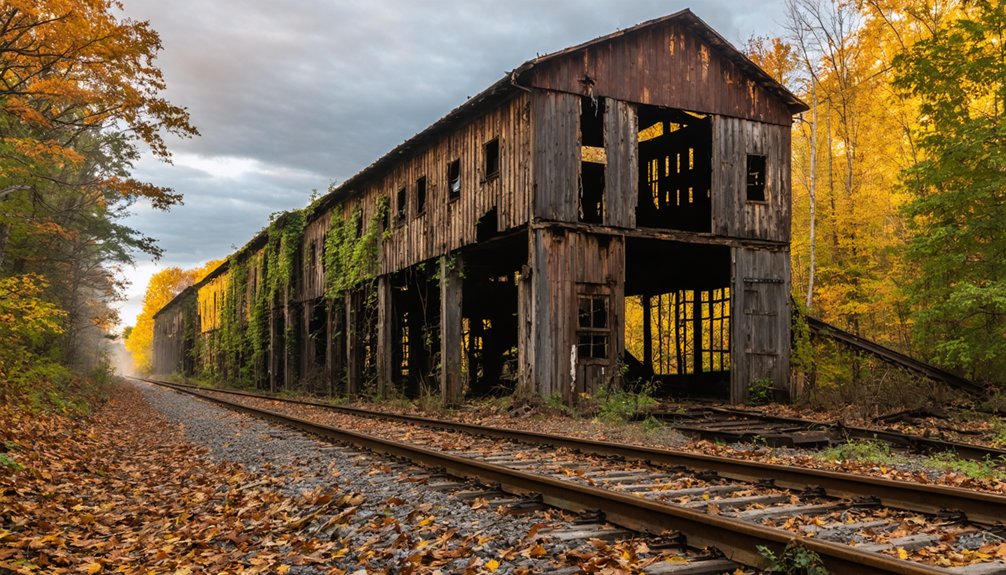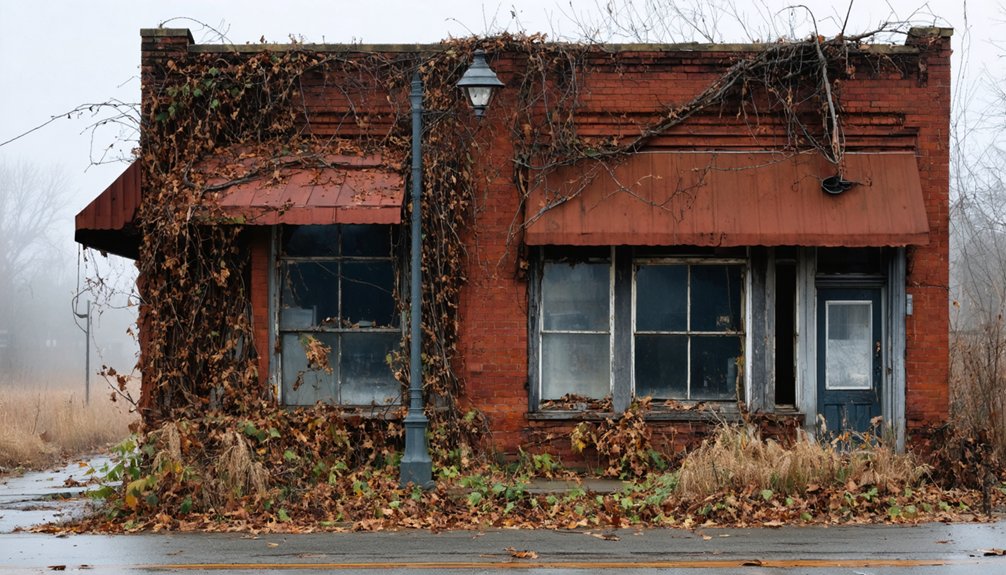You’ll find the ghost town of Dunn, Indiana about 1.5 miles east of Dunnington, where it once thrived as a bustling railroad community in the late 19th century. The town featured a grain elevator, two general stores, and a post office along the north-south railway line until its decline began with the post office’s closure in 1913. Today, only the abandoned grain elevator and scattered foundations remain, marking the intersection of Parish Grove and Hickory Grove Townships. The story of this vanished community reveals fascinating insights into Indiana’s railroad era.
Key Takeaways
- Dunn, Indiana is an abandoned railroad town located at the intersection of Parish Grove and Hickory Grove Townships.
- The ghost town’s most prominent remaining structure is an abandoned grain elevator alongside overgrown railroad tracks.
- Founded in the late 19th century, Dunn declined after its post office closed in 1913 and businesses shuttered through the 1920s.
- Approximately six deteriorating houses remain on the site, which lies about 1.5 miles east of Dunnington.
- The town’s abandonment followed the decline of its railroad-based economy, which once supported two general stores and agricultural commerce.
The Birth of a Railroad Town
When the railroad line established its north-south route through what would become Dunn, Indiana, in the late 19th century, it laid the foundation for a small but bustling agricultural community.
The railroad’s significance became apparent as it transformed the rural settlement, spurring the construction of essential infrastructure including a grain elevator and two general stores by the 1920s. A local family, the Dunns, gained prominence in the region through Isaac Dunn’s bridge, which was built to transport farming equipment. To prevent confusion with other locations named Dunn, the town maintained clear distinctions in official records.
The railroad’s arrival catalyzed rural growth, bringing vital infrastructure and commerce to transform isolated farmland into a thriving community.
In the wake of the Civil War, Indiana’s expanding rail network brought unprecedented opportunities to towns like Dunn.
You’ll find that the settlement’s agricultural development flourished as the railway provided critical transport links throughout Benton County. Farmers could now efficiently move their grain to market, while the stores served the growing population drawn to the area’s newfound connectivity and commercial prospects.
Captain James Dunn’s Legacy
You’ll find that Captain James Dunn‘s influence shaped the early identity of this Indiana settlement, though specific details of his railroad leadership role remain largely undocumented in historical records.
The town’s naming after him in the early 1900s reflects his presumed significance to the local rail line development, even as concrete evidence of his contributions has been lost to time.
While the captain’s military service and personal history have become obscured, his legacy endures through the ghost town that once bore his name at the intersection of Parish Grove and Hickory Grove Townships. The small-town atmosphere that once characterized Dunn lives on through local stories and community memories. Much like the mounted infantry regiment he served with in Kentucky, his impact on transportation and regional development left an enduring mark.
Early Railroad Leadership Role
During the early development of Dunn, Indiana, Captain James Dunn emerged as a significant figure whose legacy shaped both regional security and railroad advancement. At 5’7″ with a sturdy 39-42″ chest, this grey-eyed leader understood that railroad infrastructure would be essential for the region’s future.
Like many Irish settlers in Leinster, his family had deep roots in Ireland before coming to America. You’ll find his influence evident in how the town strategically positioned itself along the railway, creating economic opportunities that attracted settlers and businesses. Like his relative John Robert Karr Dunn, he helped establish important milestones for the community’s growth.
As you explore the town’s history, you’ll discover how Captain Dunn’s military expertise in protecting Madison from Indian attacks complemented his vision for regional connectivity.
While managing security concerns at age 40, he also helped establish the foundation for a transportation network that would connect Dunn to critical trade routes throughout Indiana.
Local Name’s Lasting Impact
The legacy of Captain James Dunn endures primarily through the town’s name, despite limited historical records about his specific contributions to the community.
The local influence of his namesake is evidenced in the town’s early development, where his recognition shaped the identity of this Benton County settlement during its brief period of activity. As the eldest of eleven children who later served his country, Dunn’s family history reinforced the town’s patriotic foundations. His family’s deep commitment to Indiana education helped establish important learning institutions in the state.
- The town’s establishment in the early 1900s marked Captain Dunn’s historical significance to the region
- Two general stores and a grain elevator operated during the 1920s under his commemorative name
- Post office operations from 1907 to 1913 carried his legacy through official correspondence
- The geographical coordinates 40°33′50″N 87°27′50″W permanently mark his remembered presence
- While now a ghost town, the name “Dunn” continues to appear on historical maps and records
Life Along the Tracks
Like many Indiana railroad towns, Dunn’s daily rhythms centered on the Louisville, New Albany & Chicago’s steady flow of passengers, freight, and workers.
You’d find local businesses, including sawmills and grain elevators, clustered near the station, where they served both residents and railroad employees.
The station area became the town’s social hub, where you could witness the regular mix of travelers, merchants, and rail workers conducting business while families gathered for community events near the tracks. Similar to how the Ohio & Mississippi Railroad helped develop other communities in the 1850s, the rail line brought vital commerce and connectivity to Dunn. Just as towns like Crocker experienced, the lamp factory brought industrial jobs and economic growth to the community.
Railroad Business Operations
Railroad business operations in Dunn flourished as part of Indiana’s broader rail expansion, which began in 1838 when the first steam train ran from North Madison to Graham’s Ford.
You’d find both freight services and passenger connections operating at modest speeds of 10-15 mph, still faster than traditional wagons or canals. The Chicago and Eastern Illinois Railroad played an essential role in the region’s development.
- Mixed trains carried both passengers and agricultural products
- Freight operations focused on livestock and manufactured goods
- Steep grades required horse assistance for heavy loads
- Dispatchers coordinated schedules and monitored weather conditions
- Bridge infrastructure proved fundamental yet vulnerable to failure
These operations faced constant challenges, from terrain difficulties to safety concerns, yet they remained crucial to Dunn’s economic growth and connectivity to surrounding markets.
Daily Community Rhythms
Living along the tracks in Dunn meant synchronizing daily routines with the railroad’s pulse, as residents adapted their agricultural and commercial activities to match train schedules.
You’d find community interactions centered around the two general stores, where locals traded news and supplies while waiting for incoming shipments.
Your daily patterns would’ve followed the agricultural cycles – planting in spring, tending crops through summer, and rushing to harvest before winter.
The grain elevator‘s operations intensified during harvest season, when you’d join other farmers bringing in your crops.
Without local schools or churches, you’d catch the train to nearby towns for education and worship.
The post office served as your lifeline to the outside world until 1913, while the general stores remained crucial gathering spots where you’d coordinate with neighbors and conduct business.
Station Area Social Life
As trains rumbled through Dunn, the station area pulsed with social energy, transforming the platform and surrounding spaces into the town’s primary gathering hub.
You’d find farmers, merchants, and locals congregating during train arrivals and departures, sharing news and engaging in impromptu station gatherings. Market days strategically aligned with train schedules, maximizing opportunities for social interactions among community members.
- General stores and grain elevators near the tracks drew steady crowds
- Train arrivals sparked spontaneous community meetups
- Local gossip networks flourished in station’s social spaces
- Weekly market activities centered around rail schedules
- Station platform served as natural mixing ground for different social groups
The station area wasn’t just a transport hub – it was your window to the wider world, where community bonds strengthened through shared experiences and daily encounters.
Economic Pillars and Daily Commerce
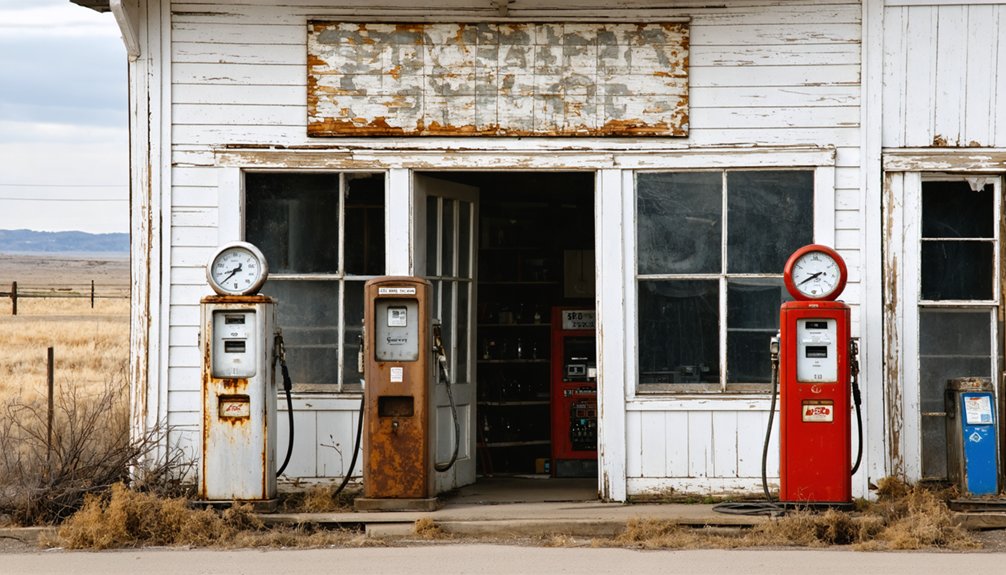
During its brief heyday in the early 1900s, Dunn’s economic foundation rested firmly on four primary pillars: the north-south railroad line, a bustling grain elevator, two general stores, and a post office.
These interconnected elements drove the town’s economic sustainability, with the railroad facilitating trade while the grain elevator processed local farm produce for regional markets.
You’d find the town’s community resilience in its daily commerce, where two general stores supplied essential goods to residents and served as social gathering spots.
The post office, operating from 1907 to 1913, connected you to the outside world through mail and money orders.
This economic framework supported about half a dozen families, though the town’s fortunes ultimately hinged on its agricultural base and rail access – dependencies that would later contribute to its decline.
Signs of Decline
The first signs of Dunn’s decline emerged when its post office closed in 1913, just six years after opening, signaling the beginning of the town’s gradual dissolution.
When Dunn’s post office shuttered in 1913, it marked the start of a small town’s slow fade into history.
You’ll find evidence of a declining population throughout the 1920s, as economic isolation took hold following the railroad’s diminishing importance.
The town’s demise became increasingly apparent through these key indicators:
- Closure of essential businesses, including general stores
- Abandonment of the crucial grain elevator operations
- Deterioration of the north-south railway infrastructure
- Exodus of families from residential properties
- Discontinuation of core community services
The Final Whistle
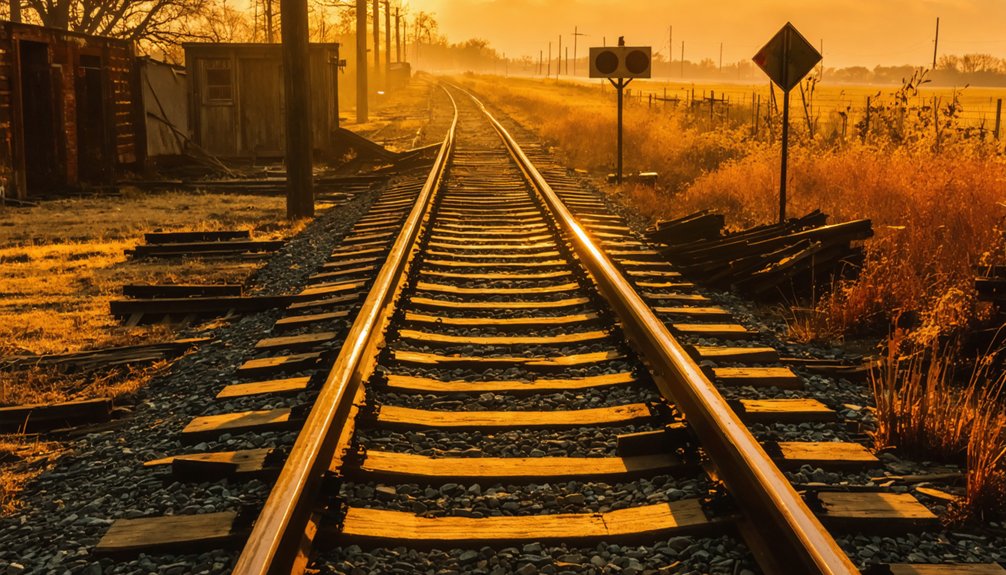
Like many railroad-dependent communities of its era, Dunn’s final chapter was marked by the silencing of locomotive whistles that once echoed through its streets.
You can trace the town’s final days through the sequential loss of essential services – first the post office in 1913, then the gradual quieting of commerce at the general store and grain elevator.
The ghostly echoes of its railroad past remain visible in the abandoned tracks and weathered grain elevator that still stand as silent sentinels.
When the last train pulled away, it took with it Dunn’s lifeline to the outside world.
Without its transportation hub and with no attempts at revitalization, the small community of six residents dispersed, leaving behind another Midwestern ghost town in Benton County’s historical tapestry.
What Remains Today
Standing sentinel along Benton County Road 300 South, Dunn’s most prominent remaining structure – an abandoned grain elevator – towers above scattered ruins of what was once a bustling railroad town.
Today, you’ll find this ghost town about 1.5 miles east of Dunnington, where nature slowly reclaims what humans left behind.
Time stands still in this forgotten settlement, where wild grasses and vines steadily erase the footprints of yesteryear.
As you explore the site, you’ll discover:
- Overgrown railroad tracks cutting through the town’s heart
- Foundations of two former general stores
- About half a dozen dilapidated houses
- The marked location of the former post office (1907-1913)
- Scattered remnants of commercial buildings
These abandoned structures tell the story of Dunn’s agricultural past, where farmland still dominates the surrounding landscape at 40.56389°N, 87.46389°W.
While easily visible from public roads, the site offers no formal access or amenities.
A Glimpse Into Indiana’s Railroad Past
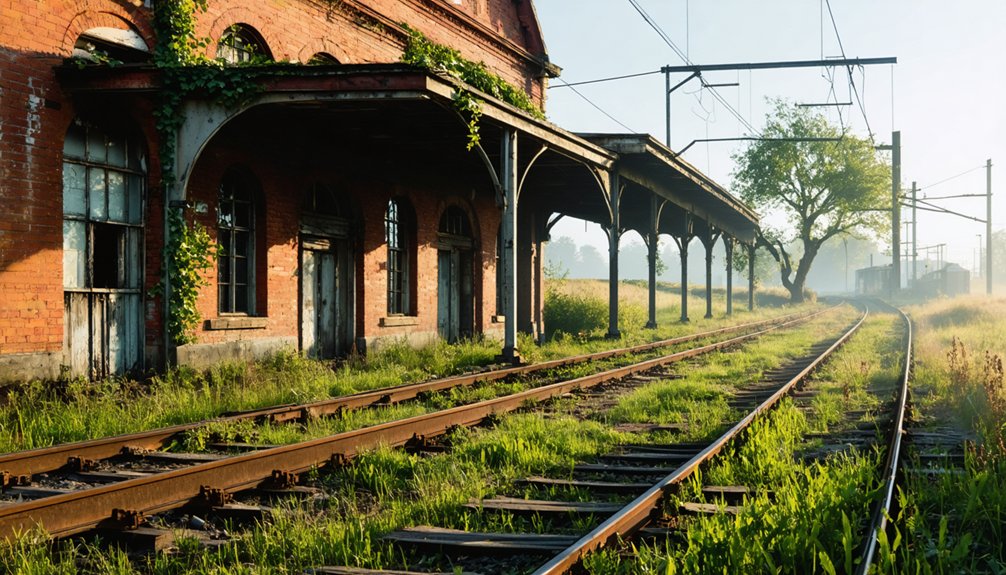
When railroads first carved through Indiana’s landscape in 1838, they revolutionized transportation and shaped the destiny of countless communities like Dunn.
You’ll find railroad innovations marked this transformative era, from the British-made Elkhorn locomotive to more practical American-built Baldwins, increasing travel speeds to 15 mph for express trains.
These changes didn’t come without rural tensions, though. Local farmers frequently clashed with railroad companies over livestock deaths on the tracks, filing claims that sometimes took poetic turns.
Notable figures like Major Thomas Searle Dunn, William Edward Dunn, and George Dunn played vital roles in shaping this era, from military projects to construction leadership.
The Chicago and Eastern Illinois Railroad, along with other major lines, ultimately connected Indiana’s towns, transforming commerce and fostering new settlements throughout the region.
Frequently Asked Questions
Are There Any Living Descendants of the Original Dunn Townspeople?
You can’t definitively confirm living descendants without extensive historical research, though family connections likely exist among current Benton County residents whose ancestors lived in this early 1900s railroad town.
What Was the Maximum Recorded Population of Dunn at Its Peak?
Precisely pinning population peaks proves problematic – you won’t find formal census records. Demographic trends suggest the town’s maximum was likely 50-100 residents during the 1920s before rapid population decline began.
Were There Any Notable Crimes or Incidents in Dunn’s History?
You won’t find any documented crimes or unsolved mysteries in the records. Historical artifacts and available research don’t reveal any notable incidents that occurred within this remote settlement’s boundaries.
Did Any Famous People Ever Visit or Pass Through Dunn?
You won’t find any documented famous visitors to this spot, and while the railroad brought many through the area, historical records don’t show any notable connections to well-known travelers.
What Indigenous Tribes Originally Inhabited the Area Before Dunn’s Establishment?
You’ll find deep tribal history there, with Paleo-Indians first inhabiting the area around 9500 BC, followed by Woodland peoples, and later the Miami and Potawatomi tribes of cultural significance by 1600 AD.
References
- https://www.onlyinyourstate.com/experiences/indiana/ghost-towns-in
- https://raregoldnuggets.com/?p=3933
- http://ingenweb.org/inlawrence/abandoned.htm
- https://en.wikipedia.org/wiki/List_of_ghost_towns_in_Indiana
- https://www.youtube.com/watch?v=Lf2AQ6YfwxE
- https://www.islands.com/1754423/city-west-ghost-town-abandoned-buildings-once-dreamy-town-indiana-coastal-eerie-dune-beach/
- http://www.porterhistory.org/2015/12/historic-dunns-bridge-on-kankakee-river.html
- https://en.wikipedia.org/wiki/Dunn
- https://freepages.genealogy.rootsweb.com/~vklein/railroad.html
- https://commons.wikimedia.org/wiki/File:Dunn
